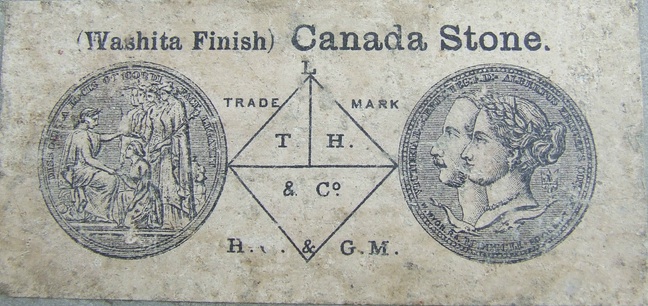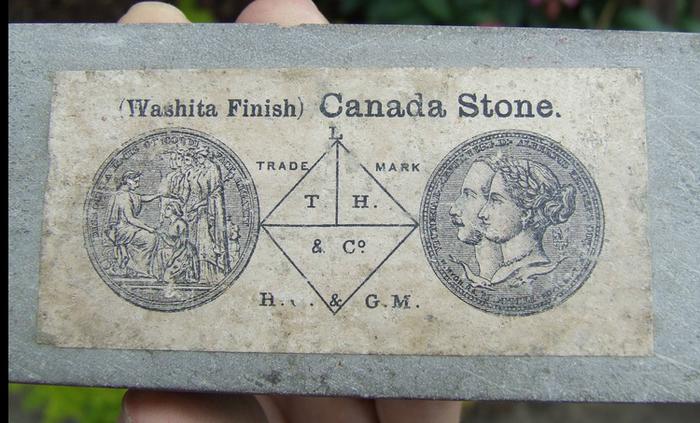Results 31 to 40 of 57
Thread: History of the "Magog Oilstone"
-
03-20-2014, 06:17 AM #31< Banned User >

- Join Date
- Jan 2009
- Location
- Seattle,Wa
- Posts
- 103
Thanked: 2
Oil tends to trap rough particulates
-
12-25-2014, 11:43 AM #32
 History of the "Magog Oilstone"
History of the "Magog Oilstone"
Something more to add on Information of the Magog Oilstone, i havent seen it posted before and doing a couple of hours research back the last half year it might be Interesting for those who are Interested in the History of the Magog Oilstone and Roman Fyler....
More about the Stone and its Name/Quality, this was taken from here. I marked some interesting passages...
https://archive.org/stream/handbookf...0dixj_djvu.txt
John Ross Dix - A Handbook for Lake Memphremamog
"Near the Entrance of the East Bay there is a Island called "Whetstone or Fitch's Island" - (the latter named after a man who once claimed to own it). This Island is remarkable for a quarry of Novaculite, which maybe seen as a yellow line near the waters edge in its western side. Of this Novaculite, capital Whetstones can be made; indeed some years ago, the quarry was workedby a company from Burke, who disposed of many tons of it anually. So excellent was it, that it almost drove the famous turkey oilstone out of the market, and were beeing amply remunerated when from some cause or other, the British Government put a stop for the quarrying; not however in order to monopolize the trade itself, for since the Burke Company were driven of the Novaculite has remained undisturbed."Last edited by doorsch; 12-25-2014 at 06:26 PM.
███▓▒░░.RAZORLOVESTONES.░░▒▓███
-
12-25-2014, 03:33 PM #33

This is one stone I would like to find. My mother was born in that area of Canada
-
12-25-2014, 06:41 PM #34
 History of the "Magog Oilstone"
History of the "Magog Oilstone"
More on Roman Fyler can be found in some documents available to the public, the first text is from a "National Register of Historic Places Continuation Sheet" from the 1. April 2008:
http://pdfhost.focus.nps.gov/docs/NR...t/07001345.pdf
thats whats written down about Fyler:
"Roman Fyler (1768-1828) emigrated in September 1800, from Winsted in Litchfielf County, Conneticut with his Wife and four Children to Burke Green. In 1801 Burke built the towns first saw mill and grist mill on a small stream in Burke Hollow that came to be known as Fylers Mill Stream. Unfortunately that first saw mill burned, but it was replaced by Fyler the next year. The Village of Burke Hollow grew up around the Industry of Fylers Water Power Mills."
So that really Interesting, as it is well visible which important Role Mr. Fyler has played in the Region around Burke....Last edited by doorsch; 12-25-2014 at 06:51 PM.
███▓▒░░.RAZORLOVESTONES.░░▒▓███
-
12-25-2014, 06:50 PM #35

More can also be found here, this is taken from "Vermont Historical Magazine"
http://www.rootsweb.ancestry.com/~vt...0302_burke.htm
"ROMAN FYLER
Born in Winstead, Ct., in 1768; married to Sally Lyman in ———. In 1799, moved with his fam*ily, consisting of his wife and four children, to Burke, and located on what is now called Burke Green, a ridge of land running N. and S. through the town, dividing it nearly in the centre. Here he built him a log house, and commenced the laborious work of a pioneer. There was at that time no grist-mill nearer than Lyndon, and he, as well as other settlers, was often under the neces*sity of going to Barnet to purchase grain and bringing it to Lyndon to be ground, and from thence home, his path guided by marked trees. In 1801, he built the first grist-mill in town, and subsequently added 2 grist-mills and 2 saw-mills.
In 1803, he met with a serious accident in one of his mills, having his foot and ankle severely crushed, which troubled him more or less to the close of his life. He was one of the company that, about the year 1806, built the road through the Notch of the White Mountains in N. H. He also formed one of the company that built the turnpike through the town of Barnet. He was one of the "early few" who represented the town in "olden times;" was also town clerk a number of years, besides holding many other offices of trust, always discharging his duty with fidelity and zeal. In religious sentiments he favored the Methodists, of which his wife was a member. In physical proportions he was almost gigantic. It has been asserted, moreover, that he was the strongest man ever in town. He died in the year 1828."███▓▒░░.RAZORLOVESTONES.░░▒▓███
-
-
04-14-2015, 02:20 AM #36Senior Member


- Join Date
- Jul 2011
- Posts
- 2,110
Thanked: 459
Only about 2 1/2 years late here, but washitas were stones sold to joiners and carpenters. One shop session with one (and no other stones) illuminates quickly why they were so valued for woodwork and charnleys were not. A good charn is a capable razor finisher, and only the very fine washitas are. Refreshing a plane iron or chisel is something that can be done every 15 or 20 minutes in heavy use, and the amount of material to remove is probably 50 times what has to come off of a razor.
Before that, the English had sandstone grindstones to use, and a lot of slow cutting stones on top of that. It's by luck that the washita is ideally suited to cut steel about as hard as sheffield steel of the mid 1800s. Any harder, and the stones get slow cutting, any softer, and they cut too deeply and the edge isn't that fine. But at the hardness of the iron in the long plane in this video ( an old laminated butcher iron), just perfect.
-
04-14-2015, 02:35 AM #37

Thanks Dave for adding the Vid, for me an really interesting View into woodworking topics.....
███▓▒░░.RAZORLOVESTONES.░░▒▓███
-
04-14-2015, 09:44 PM #38Senior Member

- Join Date
- Mar 2009
- Posts
- 1,211
Thanked: 202
I have tried few of each (Washita incl. Lilly White, CF and Old Turkey. At present I have not much time for razors as most of it is spent with other sharp tools mainly woodworking.
In my opinion Washita on razors is at max as prefinisher but is fast. Old Turkey is capable of doing most of the rough work as well as to finish razor and is fast ish depending on example. CF is realy just finisher slow but very fine.
For woodworking tools CF is for very fine woodworking tools only otherwise it not very effective for their work.
Old Turkey I realy like but to get one which is big enough and not too much damaged is challenge.
Washita is relatively fast (of naturals), hard wearing with narrow tools most usefull for general woodworking tools. I would say that I can understand why it is number one for woodworkers as thir steel is not as hard (usually) as razors and also the edge has more meat to support itself unlike razors. There are known naturals which will destroy edge of razors with lesser quality steel.
-
08-09-2015, 08:37 AM #39Junior Member

- Join Date
- Aug 2015
- Location
- Lake District, Cumbria UK
- Posts
- 5
Thanked: 1
Hi Guys, I know it has been a while now since there has been any further updates to this topic, I have a couple of stones with labels on them, I wonder what your thoughts are, they both fit the bill in looks and age, once again there is no reference to Magog on any of the Labels that I can see,
any thoughts would be well received.


many thanks steve
-
08-09-2015, 02:40 PM #40Historically Inquisitive



- Join Date
- Aug 2011
- Location
- Upstate New York
- Posts
- 5,782
- Blog Entries
- 1
Thanked: 4249
Interesting stone, thanks for posting it. Would like to see the other side as well. Washita finish on the label make me thinks its comparable to the Arkansas Washita, a pretty coarse stone in the razors world. Nevertheless preserve that label well.


 63Likes
63Likes LinkBack URL
LinkBack URL About LinkBacks
About LinkBacks






 Reply With Quote
Reply With Quote
